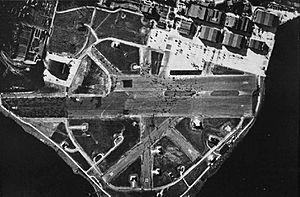Naval Station Puget Sound facts for kids
Naval Station Puget Sound was a former U.S. Navy base. It was located on Sand Point in Seattle, Washington. Today, this land is part of Magnuson Park, a popular public park.
After World War I, people wanted to build a Navy air station at Sand Point. King County started buying land for this purpose. In 1922, the U.S. Navy began building on the site. They were leasing the land from the county.
By 1926, King County officially gave the 413-acre field to the Navy. This was like a big public gift to help the Navy.
Sand Point Airfield became famous in 1924. It was the ending point for the first aerial circumnavigation of the world. This means airplanes flew all the way around the world for the first time! This historic flight helped convince the government to develop Sand Point as a full Naval Air Station.
Before the U.S. entered World War II, the airfield was updated. The grass runways were paved in 1940 and 1941. The main runway was about a mile long.
During its active years, Naval Station Puget Sound was a place to train Navy pilots. Sometimes, trainer aircraft had problems and crashed into Lake Washington. These plane wrecks are still underwater near what is now Magnuson Park. Local divers often visit them.
- In 1956, a PB4Y Privateer plane crashed shortly after takeoff. It is now under 155 feet of water near the boat ramp.
- In 1947, a PV-2 Harpoon plane crashed while trying to land. It is now under 140 feet of water off Sand Point.
Deactivation and New Beginnings
Naval Air Station Seattle was closed down in 1970. The airfield stopped operating. The smaller base was then called "Naval Support Activity Seattle."
Discussions began about what would happen to the extra land. In 1975, a large part of the Navy's land was given to the City of Seattle. Some land also went to the National Oceanic and Atmospheric Administration (NOAA).
The city's land was mostly turned into a park. It was first named Sand Point Park. In 1977, it was renamed Magnuson Park. This was to honor Warren Magnuson, a U.S. Senator from Seattle who was also a former naval officer.
The old airfield runways were removed in the late 1970s. New buildings for NOAA were finished in 1982. The base was renamed "Naval Station Puget Sound" in 1986. It was officially recommended for closure in 1991. The remaining land was divided among different groups, including the city. The base finally closed in September 1995.
The former naval station is now an important historical site. It was added to the National Register of Historic Places in 2010. It was also named a Seattle landmark in 2011.


